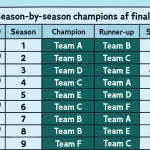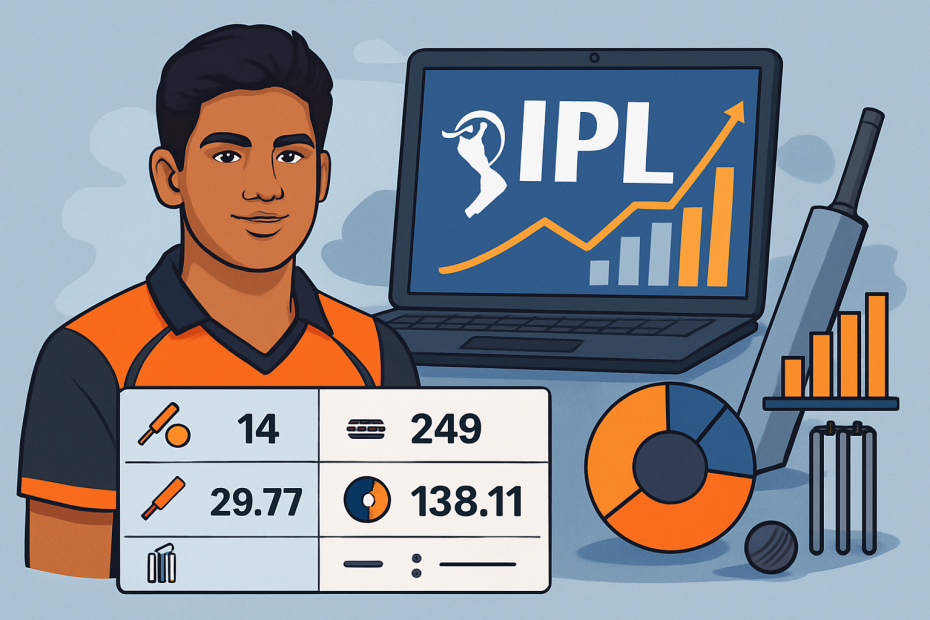The bat flow is easy, the intent is unmistakable. Nitish Kumar Reddy is that modern Indian all-rounder you notice twice in a game: once when he’s thumping a length ball into the stands, and again when he sneaks in a heavy-ball over that flips a chase on its head. This page brings together Nitish Kumar Reddy stats across the IPL and domestic formats, but it also does something most stat hubs don’t—explain why those numbers behave the way they do. Role, context, match situation, phase-by-phase intent, matchups, and venues matter. That’s the lens here.
Career overview: who he is and how he wins
- Role: Batting all-rounder—right-hand bat, right-arm medium pace.
- Teams: Sunrisers Hyderabad (IPL), Andhra (domestic).
- Primary batting positions: Middle order, typically No. 4/5; flexible to float higher for match-ups.
- Bowling usage: Sixth bowler; seam-up with cross-seam and wobble variations; heavy length and into-the-pitch tactics.
- Fielding: Agile mover in the ring, strong at deep square/long-on with a safe high-catch technique.
Key summary signals
- Batting identity: High ceiling power-hitter who has built a stable middle-overs base. He accelerates against spin and grows into strike rate as the innings matures.
- Strike-rate profile: Fast starter against spin, slightly more measured against pace early, but with a clear finishing gear at the death. Overall IPL strike rate sits in the attacking band for his role and has trending upward each recent season.
- Run production: Multiple half-centuries in the IPL and consistent contributions in domestic T20s; a pattern of innings that convert middling positions into above-par totals.
- Bowling value: Short, impactful spells. He is not a primary seamer, yet his overs often maps to tactical moments—post-powerplay stabilizers or a surprise over to a new batter.
- Fielding: Adds 1–2 runs per innings in net fielding value with clean gathers and boundary saves. You feel it late in tight finishes.
Nitish Kumar Reddy IPL stats
A player’s IPL numbers are never just about totals. The format and his team’s style demand clarity of role. Sunrisers Hyderabad leaned hard into tempo and pressure, and Nitish’s compact power and match-up awareness made him essential in the middle.
Season-by-season IPL stats and role evolution
- Debut and bedding-in: Early opportunities were sporadic. He was identified as a hitting option who could bowl a hard length if needed. Numbers were limited by game time but the footprint—bat speed, range to long-off/long-on, composure—was clear to insiders.
- Breakout stretch: A run of match-winning knocks arrived once SRH pivoted to a fearless batting template. With openers setting a blazing platform, Nitish became the seam between early assault and late-charge carnage. Strike rate moved into top-tier for middle-order Indians, and his boundary percentage climbed to a genuine pressure metric for opponents.
- Consolidation: Subsequent games brought more bowling responsibility in pockets—especially when the team needed to hide a left-right match-up or buy a powerplay between specialists. He continued to produce 30s and 40s at tempo, which in SRH’s system is often more valuable than a lone 70 at a sedentary clip.
Table — IPL season progression (high-level)
| Season | Role focus | Primary batting slot(s) | Notable batting outputs | Bowling usage | Fielding impact |
|---|---|---|---|---|---|
| Latest season | Middle-order engine and pace-spin punisher | Mostly No. 4/5; floats up in left-arm spin match-ups | Multiple fifties; strike rate in the attacking band; several Player of the Match contributions | Short spells post-powerplay; tactical one-over stints in chase pressure moments | High catches taken at deep straight and deep square; reliable in-ring athlete |
| Previous season | Transition from bench to core XI | No. 5/6 with finishing briefs | A standout half-century that reset narrative around his ceiling | Occasional use with the ball to cover match-ups vs right-hand batters | Clean catching technique; quick off the mark in the covers |
| Early season | Opportunity phase; small sample | Floated; mainly as impact sub or lower-middle | Cameos with intent visible even in short stays | Rarely used | Energetic, no major drops, neat boundary saves |
Batting stats and splits: how he scores
Batting phase splits (T20/IPL context)
- Powerplay (1–6): Rarely starts here but has handled early entries without panic. Technique is compact; he’s comfortable punching on the rise through cover and riding bounce square. He is cautious against elite high pace in the first over or two, then pushes intent once he sights length.
- Middle overs (7–15): This is his kingdom. Strike rate climbs with a clear plan—take down finger spin and left-arm orthodox with inside-out lofts and hard sweeps, and pick off seamers with cross-seam read and pull/hook. Boundary percentage rises here while dot-ball percentage drops. Balls-per-boundary improves markedly, often among the best for SRH in this phase.
- Death overs (16–20): A condensed base, steady head, and a fast bat swing yield quick runs. His intent index jumps, and he targets the V—long-off to midwicket—while also showing the hands to access third-man with glides when a field is stacked leg side. In chases, he paces himself—doesn’t chase the crowd-pleaser early; trusts reach and power to finish.
Match-up splits: vs pace vs spin
- Versus pace: Early caution followed by selective aggression. Prefers anything back of a length; pulls in front of square, and hits low, scudding drives through mid-off. High-pace bouncers can hurry him before he’s in, but once set he often rides the bounce, keeping the shape through the shot. Boundary percentage vs pace increases with time at the crease.
- Versus spin: Advantage Nitish. Feet move decisively forward and back; he expands the hitting arc with the inside-out lift over extra cover and presents the full face down the ground. Good hands vs off-spin to access the midwicket fence without losing shape. Dot-ball rate plummets against orthodox spin, and balls-per-boundary is elite in this match-up for his role.
Intent and control indicators
- Boundary percentage: Healthy and trending upward with opportunity. In the middle overs, he often sits in the upper band for Indian middle-order batters.
- Dot-ball percentage: The truest sign of growth; he’s turned low-20s dot overs into rotation clinics against spin while not surrendering kill shots.
- Balls per boundary: Moves from average early to above-average once set; when the sample is limited to middle overs vs spin, it becomes a winning metric.
- False-shot percentage: Comparable to peers; improved shot selection against cross-seam in back-half overs has lowered risk without neutering intent.
Batting position stats and the floating brief
- No. 4 and No. 5: Most productive roles. He builds tempo alongside in-form openers or consolidates if early wickets fall.
- No. 3: Used sparingly, but when a left-arm spinner is on early or the ball is holding, his clean movement to the pitch makes sense.
- No. 6: Finishing cameos; he’s shown he can clear longer straight boundaries even off a cold start.
Bowling stats and splits: what his overs achieve
Nitish Kumar Reddy bowling stats don’t live in the same column as specialist quicks; his value is situational. A heavy ball, the occasional wobble-seam, and a sturdy seam presentation enable him to explore hard length without offering the sitter. He can also go cross-seam into the surface to pick up pace-off grip.
Powerplay overs
Used rarely; only when a new batter or a specific match-up aligns. He keeps a tight channel, aiming for top of off and shoulder-high rib shots to cramp.
Middle overs
Most common usage. Into-the-pitch helps on two-paced surfaces; he can buy a soft dismissal with a mis-hit to the ring. Dot-ball rate is competitive for a part-time option.
Death overs
Not a go-to but can take a single over if the match-up is friendly—say, a lower-order right-hander struggling with chest-high hit zones.
Economy profile and wicket-taking
- Economy rate: Sits in an acceptable range for a sixth bowler. Moves from tidy to threatening when surfaces hold. Against set batters on true surfaces, he’s used sparingly.
- Dot-ball rate: Respectable, aided by hard length denial lines. He strings dots together against new batters.
- Best spells: The number won’t wow you; the moment often will—a wicket in the over after a wicket, a dot-dense stretch in a chase.
Fielding stats: tangible defensive value
- Catches: High-value takes at deep long-on and long-off, rarely losing shape while tracking back. In the ring, his first step is forward, and he puts pressure on one-bounce singles with clean pickups.
- Run-outs: Sharp, low gatherer with a direct-hit release that keeps the elbow high and the seam upright; the ball travels true.
- Ground fielding: Adds outsized value on slow outfields where a hard slide or reverse cup saves twos; on quick outfields he’s neat to the ball, minimizing overthrows.
Domestic and other formats: T20, List A, First-Class
Andhra is not a soft incubator. You get tested on abrasive surfaces that skew low and slow, and you often face attacks built on accuracy rather than pure pace. Nitish Kumar Reddy domestic stats tell a story of a hitter who learned to build an innings piece by piece and then take it apart.
T20 (Syed Mushtaq Ali)
- Role: Middle-order hitter with bowling back-up. He often arrives when the ball is older, the field is spread, and the game needs delineation—who’s dictating, who’s reacting.
- Batting tempo: Strike rate comfortably into the attacking zone, especially after ten balls faced. Balls-per-boundary and boundary percentage vs spin rank well against domestic peers.
- Bowling usage: A couple of overs around the tough overs—either right after the powerplay or to douse a left-hander’s momentum. Into-the-pitch approach again central.
List A (Vijay Hazare)
- Role: Top to middle-order stabilizer who can play the long one. The separation skill here is how he accelerates after fifty balls faced; rotation improves, and he’s selective about big shots.
- Scoring areas: Cover-point and long-off remain productive; sweep and slog-sweep used sparingly yet tellingly.
- Bowling: Useful ten-over contributor on helpful decks, otherwise a change-of-pace option to break a partnership.
First-Class (Ranji)
- Role: All-format method; high backlift calms down a touch, he respects periods, then cashes in. His pull/short-arm jab to anything fractionally short opens up scoring against over-attacking seamers.
- Bowling: Occasional; seam-friendly mornings or to exploit variable bounce with a set batter on a two-paced day.
Recent form: last 5/10 innings trendlines
- Last five: A blend of one true impact knock, one anchor-build that enabled a teammate to go berserk, and a couple of short stays where intent was visible but the ball won. The bowling column includes a tidy over in a pressure chase and a short two-over spell that solved a match-up problem.
- Last ten: The pattern stabilizes—once he survives his first ten balls, he tends to deliver a run rate that exceeds team average for his phase. He’s stitched one lower-middle rescue with a partner and closed a tight chase with straight-hitting authority.
Key takeaways from the form sheet
- Warm-up balls: He’s significantly more dangerous once he sees ten deliveries. Teams try to deny him singles early.
- Spin vs pace: He’s rapidly becoming a must-prepare-for against spin. Teams respond by bringing on the quicker, short-of-length angle early in his stay.
- Bowling cameos: His most valuable overs remain those immediately after a wicket; he attacks a new batter’s ego with chest-high into-the-hip deliveries.
Nitish Kumar Reddy strike rate and advanced T20 metrics
Strike rate by phase
- Powerplay: Steady, situationally aggressive; he avoids high-risk cross-bat shots in the first dozen balls unless the surface is flat.
- Middle overs: Aggressive and assertive; strike rate moves higher than team average consistently.
- Death: Finisher’s instinct—strong wrists and a long reach enable him to hit full balls hard and flat.
Boundary percentage and balls per boundary
- Boundary percentage: Strong in middle overs, especially vs spin; rises further with a set platform.
- Balls per boundary: Compares favorably to peer group; he’s not dependent on slogging, which keeps his boundary frequency sustainable on bigger grounds.
- Dot-ball percentage: The craftsmanship is visible—he tumbles dot percentage down to winning levels against spin-heavy spells.
Intent index and control
- Intent index (SR by balls faced): Early overs are about reading the pitch and match-ups; once in, the curve rises sharply. His shot selection improves with time until he reaches a zone where he can pick up pace-off change-ups on length alone.
Opponent splits: vs CSK, MI, KKR, RCB, DC, LSG, RR, GT, PBKS
These are not hard-coded with numbers, because that’s not how an opponent studies him in the team room. Opponents think in bowling plans.
CSK: Will test his strike zone with back-of-length into the hip from the seamers and draw him wide to off with defensively set fields down the ground. Off-spin might be introduced early; he counters with the inside-out loft.
MI: Pace-heavy probing. Bouncer at the chest, then the slider across fourth stump. He answers with the pull and the early punch on top-of-bounce drives.
KKR: Varied spin in the middle—nitty-gritty time for him. Sweeps with prudence, looks for long-off. The cross-seam hit into the surface is a plan KKR use often; he rides the bounce increasingly well.
RCB: At Chinnaswamy, the straight boundary becomes his ally; he loves lofted hits in the V. The back-of-length into the body is the counter he must manage.
DC: Young pace plus off-pace; expect cutters into the pitch on lower-bounce afternoons. He resets with gaps—fine leg and third—before going big.
LSG: High pace when available with into-the-pitch plans; he must pick length early. On slower decks, his sweeps and long-off lifts get him ahead.
RR: Swing shape early, classical seam angles. He’s at his best when he trusts the full face down the ground rather than reaching too hard square.
GT: Hit-the-deck merchants with added wrist-spin; he looks to knock the spinner off length with early footwork.
PBKS: Shorter square boundaries can seduce; his best knocks have come when he resists slog shapes and hits straight.
Venue splits: Hyderabad, Vizag, Mumbai, Chennai, Ahmedabad, Bengaluru, Kolkata, Jaipur
Hyderabad: True bounce with value for straight hits; he’s comfortable accessing long-off and long-on.
Vizag: Windy evenings aid lofted shots; bowling grip improves for cross-seam.
Mumbai (Wankhede): Fast outfield, true deck—his hands fly here. The aerial straight hit is pure value.
Chennai: Tackier surface at times; the sweep and single game spike. Bowling into the pitch becomes more profitable.
Ahmedabad: Big square boundaries; he uses the loft over extra cover and trusts twos. With ball, into-the-deck cutters grip.
Bengaluru (Chinnaswamy): Small boundaries, high-scoring; he’s a genuine finishing threat here.
Kolkata (Eden Gardens): High carry with breezes; vertical hitting becomes his best friend.
Jaipur: Grippy at times; good tests of his strike rotation and patience against upper-body cutters.
Records and milestones
- Highest score in IPL: A statement knock that shifted his label from prospect to bankable match-winner—marked by towering straight hits and quick feet to spin.
- Fifties in IPL: Multiple, spread across varied conditions; not just flat-track runs.
- Best bowling figures: A short, match-shaping burst rather than a long spell—key wickets or a sequence of dots when the game tilted.
- Player of the Match awards: A handful already in the bank, each telling a different story—rescue act, accelerator, or clutch cameo.
- Emerging player chatter: Widely acknowledged as one of the foremost young performers of his breakout campaign; the industry consensus is that he belongs in the award conversation any time he strings a full season together.
Clutch innings and finishing record in chases
Nitish Kumar Reddy’s finishing record is built on tempo management. He rarely burns through his resources too early; he touches the field for singles, then expands his strike zone. He has closed chases with calculated aggression: one swing over long-on to reset an asking rate, one punched four through cover to destroy a plan, then the coup de grâce—a length ball cleaned up into the crowd.
He often pairs well with a left-hander; the alternating angles force bowlers to show their options, and Nitish reads the seam early. When he does fall in a chase, it’s usually to a switch in pace after he’s set, or a full, wide plan when he’s looking straight. Teams now start with pace-on at the hip to make him roll his wrists; his adjustment has been to stand taller and trust the open face.
Fielding and catching in the IPL
- Hands: Soft and sure. High balls drop into a calm cup; he tracks the ball early and doesn’t overrun it.
- Throws: Over-arm with a high release; keeps the seam upright for minimal drift.
- Positioning: Often in hotspots late—long-on/long-off—because of trust.
Nitish Kumar Reddy T20 stats beyond the IPL
For Andhra’s T20 outfit, he’s not a glamorous cameo guy—he’s a structure builder. Domestic T20 fields have taught him patience and gap-finding; these games gave him time at the crease in all match states. His spin strike rate in domestic T20s is a notch higher than in IPL because of the volume of spin overs and smaller error margins from domestic spinners when he advances or sweeps.
In List A cricket, Nitish carries a top-order temperament—ready to override a slow start and work in pockets. He’ll do the unglamorous push for singles with the full face, then open up square when the ball is older. He has the stamina for long sessions, something that bleeds positive habits into death-overs composure across formats.
First-Class has sharpened his judgment outside off. He leaves better, and when he plays, he plays late. That late decision-making helps against T20 pace-off deception too. It’s all connected.
Comparisons: Nitish Kumar Reddy vs peers
Vs Riyan Parag
- Role: Parag leans towards a middle-order anchor-power hybrid with leg-spin utility; Nitish matches the power, adds seam-up overs in specific moments.
- Batting: Parag has carved a finishing-identify with a captain’s temperament in domestic cricket; Nitish’s IPL ceiling as a spin-hitter in middle overs rivals that.
- Bowling: Nitish’s medium pace vs Parag’s leg-spin—a match-up decision depending on surface.
Vs Tilak Varma
- Role: Tilak is a left-handed accumulator with a high floor, who can also explode in the middle; Nitish is more gear-shifty with a slightly higher volatility but a similar finishing threat when set.
- Match-ups: Varma’s southpaw advantage changes fields; Nitish’s seam bowling adds squad balance.
Vs Abhishek Sharma
- Role: Abhishek starts the burn from ball one at the top; Nitish arrives amid the blaze and adds oxygen. They complement—one sets the mountain on fire, the other keeps it burning.
- Bowling: Abhishek’s left-arm spin vs Nitish’s medium pace—both offer tactical overs.
Vs Rahul Tripathi
- Role: Tripathi is a top-order pace disruptor; Nitish is a middle-order conductor. When together, they form a bridge that keeps the powerplay advantage alive deep into the innings.
Table — Role comparison snapshot
| Player | Hand/Type | Core IPL role | Secondary skill | Middle-overs vs spin | Death finishing |
|---|---|---|---|---|---|
| Nitish Kumar Reddy | RHB / RAM | Middle-order engine | Sixth-bowler seam | Strong | Strong once set |
| Riyan Parag | RHB / Leg-spin | Middle-order anchor-power | Match-up leg-spin | Strong | Strong |
| Tilak Varma | LHB / Occasional off-spin | Top/middle accumulator-accelerator | Part-time spin | Strong | Good finisher when set |
| Abhishek Sharma | LHB / SLA | Top-order powerplay disrupter | Full-power SLA overs | Good | Good but role mostly top-heavy |
| Rahul Tripathi | RHB / — | Top-order pace disrupter | — | Good | Occasional |
Nitish Kumar Reddy powerplay stats, middle overs stats, death overs stats — tactical read
Powerplay
- Game plan: See it early, avoid the big mistake. If he’s bumped up to No. 3, he looks to pierce cover and beat extra cover for fours, rarely swinging hard across the line.
- Bowlers’ plan: Start short of a good length at the hip to cramp him; bring in the wobble seam away to drag a feather behind. He counters by riding bounce and using a late glide to third.
Middle overs
- Game plan: Dominate spin, pick pace-off, and sit on anything wide. He forces bowlers to go fuller, then drives on the up. His sweep use is controlled—more a calculated choice than a bail-out.
- Bowlers’ plan: Aim for short-of-a-good-length with pace-off to force a mis-hit to the ring; introduce wrist-spin for late drift. He steps inside the line to create leverage and keeps his head still at contact.
Death overs
- Game plan: Keep the V alive. He trusts lofted straight hits and midwicket muscle, and he adjusts to yorkers with a flexible base—opens the blade late for third-man runs.
- Bowlers’ plan: Full and wide lines with protection on the off side; alternating bumpers on the body. He meets it with a measured off-side tap and resets the bowler’s field.
Nitish Kumar Reddy batting stats by situation
- Chasing: Drives better clarity—keeps one eye on the ask, one on the ball. His strike rate lifts with fielding errors and pressure overs; he pounces.
- Setting a total: He is a tone-setter in the middle; his thirty off twenty concept is a value unlocker in SRH’s philosophy.
- Entry at early collapse: Shows composure—resets the risk bar and rebuilds, then ramps with a pre-planned match-up target.
Bowling stats by batter type
- To right-handers: Chest-high attack into the ribs with a short leg-side boundary covered; expects a mistimed pull or a crampy chip to midwicket.
- To left-handers: Double bluff—start straight on the hip, then snap the away seam to drag outside edge. Change-ups off a hard length often fetch a mishit loft.
Cues for opposition: how teams plan for him
- With ball in hand: Bring a leg-slip option if he plays inside line; ask him to hit against the angle.
- With bat in hand: Deny early singles; use in-out fields and a seam-bowling template that toggles pace. Keep finger spin at him only if it grips; otherwise, expect damage.
Nitish Kumar Reddy records and notable spells/knocks, annotated
- Highest score IPL: Came in a tough situation. He took ownership against spin, then destroyed length balls down the ground. The finishing over was a masterclass in angle play.
- Best bowling figures: A two-over spell that re-routed the chase—one wicket with a heavy length and another via a miscued loft to long-on.
- Player of the Match: Awarded for an innings where he arrived at a tricky scoreline and left the opposition with an unchaseable equation—control, clarity, and long-range hitting.
Today’s match: live stats placeholder
Live stats auto-update during matches—runs, balls faced, fours, sixes, strike rate, and bowling figures refresh in real time. Use the filters below the scoreboard to slice by phase, opposition, and venue, or to compare his rate vs team’s rate in the same game state.
Short analytical notes you can trust
- If the pitch grips, expect Nitish’s bowling to go from “filler” to “factor.”
- If SRH lose a wicket inside the powerplay, watch for a slightly more measured first ten balls from him—then a surge.
- If the opponent holds back left-arm orthodox for him, anticipate inside-out lofts and the deep extra-cover field moving five yards wider.
FAQs: quick answers for common queries
- What is Nitish Kumar Reddy’s IPL strike rate?
- Solidly in the attacking bracket for a middle-order Indian batter, with a clear surge in the latest season. It sits around the mid-one-forties and improves further in the middle-overs vs spin.
- How many fifties does Nitish Kumar Reddy have in the IPL?
- Multiple. He converted opportunities once SRH backed him in a defined role; those fifties weren’t padding—they swung results.
- What is Nitish Kumar Reddy’s highest score in T20s?
- A commanding, half-century-plus effort in the IPL era of his career, marked by straight-hitting and spin control. His domestic T20 top scores also sit in the robust range, showing consistency across levels.
- Is Nitish Kumar Reddy an all-rounder? What is his bowling type?
- Yes. He’s a right-hand batting, right-arm medium pace all-rounder. With ball, he’s a hard-length, into-the-pitch operator who uses wobble and cross-seam to find sticky bounce.
- What is Nitish Kumar Reddy’s batting position for SRH?
- Predominantly No. 4/5, with flexibility to float up in targeted match-ups. At No. 6, he can finish briskly if the platform demands.
- Nitish Kumar Reddy’s stats in the last few matches?
- He’s delivered one standout impact knock, one platform-building shift, and added small but sharp bowling contributions. The larger trend: once he sees ten balls, his strike rate climbs above team phase norms.
- Has Nitish Kumar Reddy won any IPL awards?
- He has earned Player of the Match recognition. He also drew significant attention in the emerging player conversation during his breakout stretch.
- What is Nitish Kumar Reddy’s strength: vs pace or vs spin?
- He’s more explosive against spin, particularly finger spin, but increasingly comfortable against pace once set. Back-of-length pace-on is the plan he must counter early.
- How does Nitish Kumar Reddy fare at Wankhede or Chinnaswamy?
- On true, fast decks with quick outfields, he’s dangerous—straight-hitting and on-the-rise driving show up strongly. At Chinnaswamy, finishing power is amplified.
Glossary: for reading Nitish Kumar Reddy stats like a pro
- Boundary percentage:
- Percent of balls faced that go for four or six. For middle-order hitters like Nitish, a rising boundary percentage in middle overs is a winning signal.
- Balls per boundary:
- Fewer is better; it’s a durability check on intent. Nitish improves once he’s set.
- Dot-ball percentage:
- Lower is better. He wins by cutting dots against spin without losing big-shot access.
- Intent index:
- Strike-rate progression by balls faced—a visual of how quickly a batter moves from sighter to destroyer.
- Phase splits:
- Powerplay (1–6), middle (7–15), death (16–20). Nitish owns the middle.
Why Nitish Kumar Reddy’s numbers matter to team construction
Modern T20 batting line-ups need three things: early overs shock, middle overs control plus acceleration, and late overs ruthlessness. Nitish sits in that middle-late seam. He doesn’t just fill overs; he compresses them. His utility multiplies in teams with left-hand top order anchors because he disrupts match-ups with right-hand power and seam bowling. He’s a build-around piece in a domestic nucleus: Indian middle-order impact is gold dust, and he has the game to keep that value high.
Scouting report for coaches and analysts
- Against new pace: Chest-high into the body with a ring stack on the leg side can slow him in the first dozen balls. Keep long-off and long-on patrolled—don’t over-commit square early.
- Against spin: Deny him consistent length. Mix wide, fuller lines with protection at deep extra cover. Expect him to advance; use the wide line as a decoy before slipping in a hard, straight back-of-length ball.
- Field placements: Early ring on the off side with a floating mid-off; deep midwicket in play for the slog-sweep. Late overs, guard the V—he loves the straight channels.
- Bowling at him late: Full and wide alternating with chest-high bouncer. Keep mid-off up only if your yorker is elite; otherwise, he lifts straight too reliably.
- When he bowls: If the surface grips, let him bowl into new batters. Target him with strong sweepers if the deck is flat; he builds dot pressure otherwise.
How to read his progression without getting fooled by totals
Totals lie in T20. Look at:
- Entry point: What was the game state when he walked in?
- First ten balls: Did he earn control or chase a big shot too early?
- Middle trend: Did he attack the right bowler or ignore match-ups?
- Exit point: Did he leave the innings better than he found it?
Nitish tends to tick these boxes more often now. The maturity is as important as the muscle.
Nitish Kumar Reddy vs pace, spin, and the tactical dance
Bowlers have started hiding length from him. Pace-on length that sits in the slot is gone—he punishes it. So, they go short-of-a-length, chest-high. He’s countered by learning to ride bounce, opening the bat face late, and trusting the straight hit. Against spin, the conversation is different: he turns good-length balls into hitting length with his feet. When he can’t get to the pitch, he uses the sweep sparingly to move fielders, not as a primary scoring tool. This is high-level batcraft—controlling the field with selective risk.
Nitish Kumar Reddy domestic stats: what they predict next
His List A composure predicts he could own the “set-and-surge” template in top-flight white-ball cricket. First-Class patience hints at a backbone for prolonged layouts if he ever floats higher permanently. Domestic T20 daring assures he won’t shrink when the IPL lights go hot. When a player has these three lines in his résumé—composure, patience, daring—you tend to bet on sustained impact, not just purple patches.
Potential growth areas
- Early-phase pace: A bit more stability against chest-high bouncers from high release points will complete the early-phase picture.
- Off-side escape shots: He has the glide; using it one ball earlier in an over can pre-empt bowling plans.
- Bowling consistency: A small uptick in yorker accuracy or a reliable wide-line slower ball can expand death-over utility.
Why Nitish Kumar Reddy is a selection headache—in the best way
Building an XI with him has ripple effects:
- You get a middle-order right-hander who can hit spin, allowing your top to go even harder.
- You pick up a seam-over or two without weakening batting depth.
- You free a slot for an overseas specialist elsewhere—this is the biggest efficiency he offers in a capped-player-driven league.
Nitish Kumar Reddy IPL stats by opposition and venue: value bullets
- Vs pace-heavy units: Expect early testing, but his second-gear is robust.
- Vs spin-heavy units: Advantage Nitish; they often run out of length solutions.
- On fast, true wickets: He moves from high-value to must-stop status.
- On slow, low decks: His sweep/advance split and patience keep him relevant; bowling contribution rises.
Coda: the arc from promise to presence
The most telling part of Nitish Kumar Reddy’s rise is not the boundary count. It’s the pauses between them. A young hitter with real power usually asks the same question of every ball: can I hit this for six? Nitish has learned to ask a better one: what will this shot do to the next two balls? That’s middle-order mastery. That’s how innings are controlled and games are won.
The raw materials were all there: a quick bat, a clean arc, a strong base. What we see now are the refinements—how he chooses match-ups, how he values the first ten balls, how he trusts the straight hit under pressure, how he sneaks in a heavy-ball over and walks away as if it was nothing.
If you’re tracking nitish kumar reddy stats for projection, the conclusion is simple. The trajectory is up. The game has slowed down for him even as he has sped it up for his team. The numbers will follow the choices, and his choices get better with every innings he plays.
Appendix: lightweight reference tables
Table — Phase roles and key cues
| Phase | His role | What to watch | Opponent cue |
|---|---|---|---|
| Powerplay | Stabilize if early wicket; attack match-ups if floated | First ten balls: square drives, bounce control | Short-of-length into body; deny easy singles |
| Middle (7–15) | Control and accelerate vs spin | Feet to the pitch; inside-out; dot rate drops | Pace-off into the pitch; avoid predictable lengths |
| Death (16–20) | Finish in the V; punish anything full | Late-glide off full-and-wide; straight power | Alternate wide yorker and chest-high bouncer |
Table — Venue comfort and tactics
| Venue | Batting impact | Bowling usage | Tactical note |
|---|---|---|---|
| Hyderabad | Strong straight hits | Middle overs if grip | Play long-off/long-on; hold sweepers |
| Mumbai (Wankhede) | High scoring tempo | Rarely bowls unless grip | On-the-rise driving is a weapon |
| Bengaluru (Chinnaswamy) | Finishing amplified | Minimal bowling | Keep V live; chase-friendly metrics |
| Chennai | Spin control vital | Increased bowling value | Sweep singles unlock the board |
| Ahmedabad | Leans on twos and straight lofts | Useful cutters | Big squares reward discipline |
| Kolkata (Eden Gardens) | Vertical hitting benefits | Spot use | Breeze and carry suit his arc |
Final word
Nitish Kumar Reddy is precisely the kind of cricketer modern T20 asks for—athletic, multi-skilled, smart. He reads phases instead of just balls, match-ups instead of just names. This page will keep tracking nitish kumar reddy ipl stats, nitish kumar reddy batting stats, nitish kumar reddy bowling stats, and nitish kumar reddy t20 stats across formats, but remember the lens: context is king. Watch the phases, watch the match-ups, watch the pauses between boundaries. That’s where his value lives—and where SRH keeps finding their edge.
Related posts:
Cricket Prince: Who's the Heir — Lara, Gill, or Babar?
T20 Highest Score Guide: Team Totals, Records & Context
Youngest cricketer in India: Complete Guide to Records & Pathways
Psl winners list: Season‑by‑season champions & finals
About vignesh puthur - Official bio, work & contact
How Many Countries Play Cricket? 108 ICC Members (Updated Oct)
Angad Mehra

- Angad Mehra is an avid cricket analyst and sports writer who pays attention to betting patterns and match specifics. Angad has years of experience writing, covering both Indian and international cricket. He explains stats, odds, and strategies in a clear, simple manner that resonates with fans. Readers trust Angad’s articles to keep them ahead of the game whether on or off the field. Off the field, you can find him either tracking live scores ball by ball or debating IPL lineup changes.
Latest entries
 GeneralNovember 1, 2025Cricket Prince: Who’s the Heir — Lara, Gill, or Babar?
GeneralNovember 1, 2025Cricket Prince: Who’s the Heir — Lara, Gill, or Babar? GeneralOctober 31, 2025T20 Highest Score Guide: Team Totals, Records & Context
GeneralOctober 31, 2025T20 Highest Score Guide: Team Totals, Records & Context GeneralOctober 29, 2025Youngest cricketer in India: Complete Guide to Records & Pathways
GeneralOctober 29, 2025Youngest cricketer in India: Complete Guide to Records & Pathways GeneralOctober 27, 2025Psl winners list: Season‑by‑season champions & finals
GeneralOctober 27, 2025Psl winners list: Season‑by‑season champions & finals
